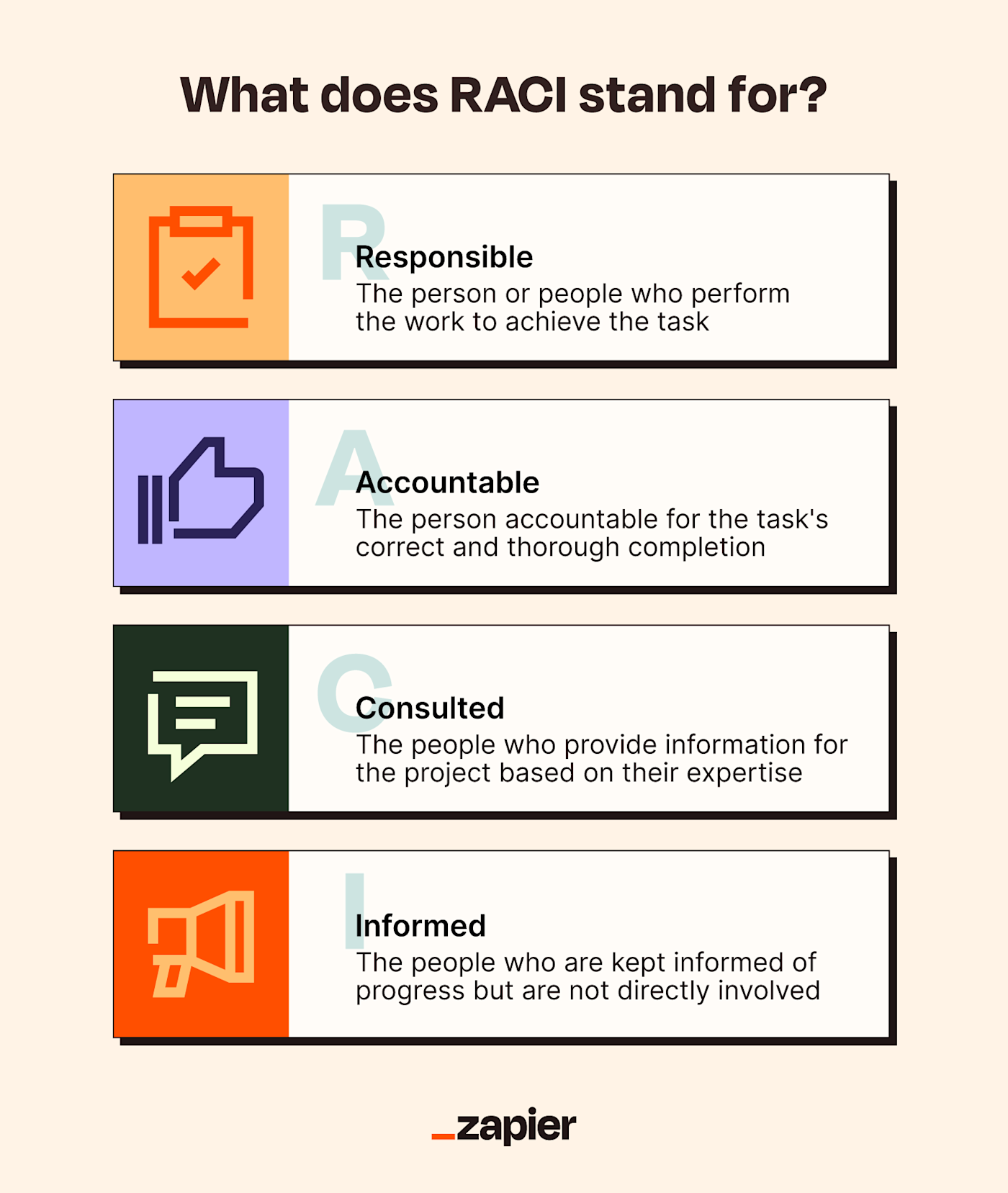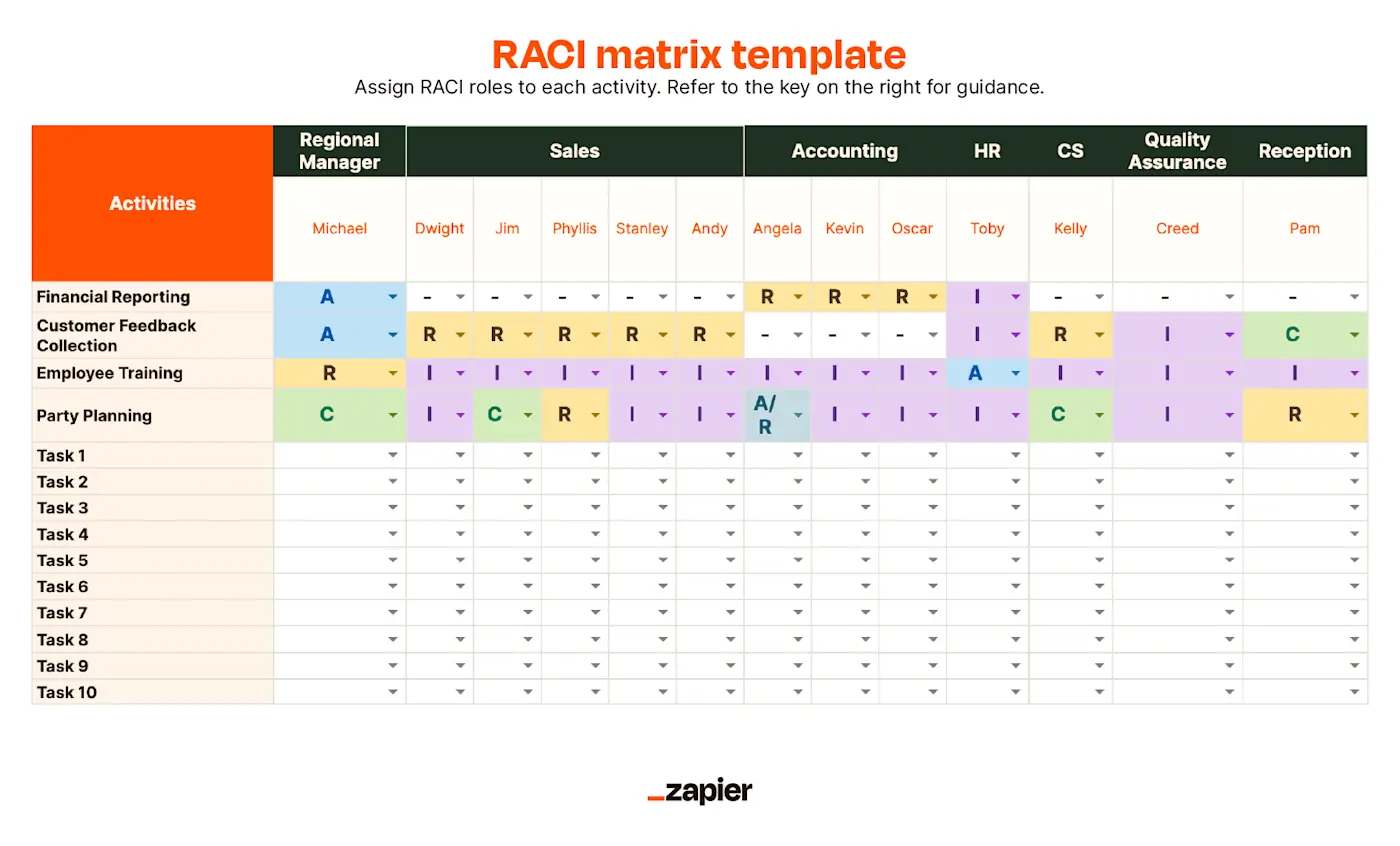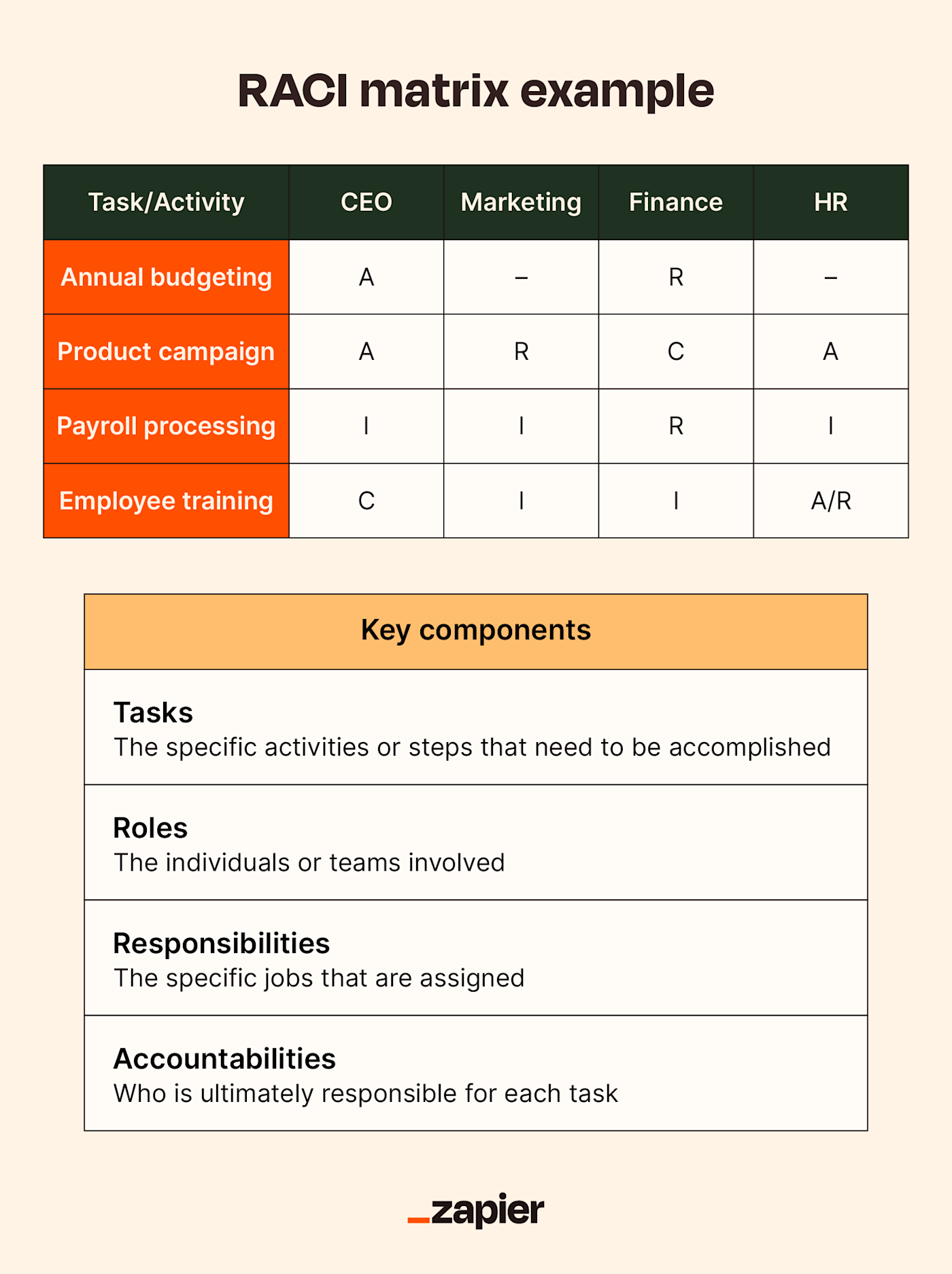A few weeks back, in a burst of misguided optimism, I found myself in an escape room with eight of my most brilliant friends. I was confident we’d bust out in record time, but we quickly realized our error: too many cooks, not enough coordination.
We really could have used RACI. The RACI model—which stands for responsible, accountable, consulted, and informed—would have gotten us the Instagram-worthy escape time we’d hoped for. This project management model ensures that there are clear roles, no conflicting ideas, and a clear communication process. Here, I’ll unpack the RACI model and how it can streamline potentially chaotic projects—and perhaps save you from your own escape room disaster.
Want to jump straight to creating your own RACI chart? Grab our free RACI template, and get started.
Table of contents:
What is the RACI model?
The RACI model, sometimes called a responsibility assignment matrix (RAM), is a project management tool for assigning roles and responsibilities to the various stakeholders of a project. Think of it as a roadmap for who’s doing what. It’s the secret ingredient to making sure your projects don’t implode in a fiery mess of miscommunication, redundant work, and misalignment.

RACI is an acronym that stands for responsible, accountable, consulted, and informed. Let’s break each of those down.
-
Responsible: This is the person who’s actually doing the thing. Think creatives, developers, analysts, and other worker bees. If we’re talking about making a sandwich, this is the person slapping the mayo on the bread.
-
Accountable: Typically in a leadership position, this is the person who’s got the final say. If that sandwich ends up being terrible, this is who you send it back to.
-
Consulted: These are the folks you chat with before making decisions. Like, “Hey, do you think we should add pickles to this?” They give input, but they’re not in the kitchen with you. In the work world, we’re talking about people like subject-matter experts, legal teams, and quality assurance teams.
-
Informed: These people are just here for the updates. “Just so you know, we’re going with pickles.” Informed parties can include external stakeholders, end users, senior management, or anyone else who needs to know what’s happening but isn’t directly involved in the action.
Importantly, RACI isn’t just for the overarching project—it’s applied to each individual task within that project. You’ll document your RACI roles in a RACI chart to be sure everything’s clear and transparent—more on that below.
Free RACI chart template

Before we dive into the examples, I want to make sure you have the tools you need to create your own RACI chart. With the help of my design team, I made a simple, easy-to-use RACI template in Google Sheets. I know it’s not handwritten on a parchment, but try to contain your disappointment.
This template has all the basic elements of a RACI chart, with space for you to fill in your project tasks and team members.
-
Project tasks are in the left column
-
Project roles are in the top row
-
Each task gets a letter: R, A, C, or I
-
Letters are applied at the intersections of rows and columns to signal the level of involvement and accountability each team member has for a specific task
Benefits of a RACI chart
There’s nothing worse than finding multiple people doing the same thing while working on a project, or neglecting an important task because everyone thinks it’s not their job.
RACI is a management tool that helps distribute tasks and assign responsibilities in a clear and transparent way. It helps people know where to go for information or approval, prevents people from passing the buck, and makes sure everyone is clear on their primary responsibilities.
Key RACI benefits include:
-
Clearly defines responsibilities and expectations: No more “Well, finance said it was ready to ship…” moments. Everyone knows their role, and there’s no stepping on toes.
-
Reduces workflow confusion: It’s like having a map in a maze. You know exactly where to go and what to do without running into dead ends or, worse, minotaurs.
-
Enhances understanding and clarity: Because there’s always someone accountable, decisions are decisive, and responsibilities are unmistakably defined. It’s like translating everyone’s thoughts into a universal language where “I thought you meant…” becomes a phrase of the past.
-
Flexible approach: RACI works for almost any project type. Whether setting up a new server or orchestrating a multi-channel marketing campaign, the RACI model can be tailored to fit your needs.
RACI chart examples and use cases
You might ask yourself, “Self, how do I know when a RACI chart is needed?” Let’s sort that out. Here are some of the situations where a RACI chart would come in handy, but you can definitely use it for lots of other use cases.
New product launch
Launching a new product isn’t just about who’s doing what. It’s about understanding the decision-making hierarchy. Who gives the final nod for the marketing strategy? Who should be consulted about production timelines? With RACI, you’re not just assigning tasks; you’re clarifying the chain of command and consultation, ensuring a smoother launch process.
|
Product manager |
Marketing lead |
Developer |
Designer |
CEO |
|
|---|---|---|---|---|---|
|
Define product features |
A |
C |
R |
C |
I |
|
Approve marketing strategy |
C |
A/R |
I |
C |
I |
|
Develop product |
C |
I |
A/R |
C |
I |
|
Design packaging |
C |
C |
I |
A/R |
I |
|
Set pricing |
A |
C |
I |
I |
R |
|
Approve launch |
C |
C |
I |
I |
A/R |
Office relocation
Ever tried moving your entire workspace without losing your favorite mug? Or your sanity? Who has the authority to choose the new location? If there’s an issue with the new space, who’s the point of contact? And before finalizing the seating arrangement, who should be consulted? RACI delegates tasks and defines the decision-making flow, ensuring a seamless transition.
|
Office manager |
Facilities |
IT manager |
Department heads |
|
|---|---|---|---|---|
|
Select new location |
C |
R |
C |
C |
|
Design floor plan |
A/R |
R |
C |
C |
|
Coordinate move logistics |
A/R |
R |
C |
I |
|
Set up IT infrastructure |
C |
C |
A/R |
I |
|
Communicate to employees |
R |
I |
I |
C |
Software implementation
Implementing new software isn’t just about installation. Who approves the software choice? Who should you consult when deciding on configurations? And if things go sideways, who’s the brave soul accountable for handling the fallout? RACI provides a clear roadmap of responsibility and consultation, ensuring the software rollout is successful.
|
IT director |
Project manager |
Vendor |
Department heads |
|
|---|---|---|---|---|
|
Select software |
A |
R |
C |
C |
|
Develop implementation plan |
C |
A/R |
C |
C |
|
Configure new software |
C |
A |
R |
C |
|
Train users |
I |
A |
R |
C |
|
Make go-live decision |
A |
R |
C |
C |
Event planning
Organizing a corporate event or conference involves many moving parts. Who has the final say on the venue? Who gives approval when you need to know if karaoke is a yea or nay? And who should be consulted when deciding between a taco bar or sushi rolls? RACI helps you streamline the communication and decision-making processes.
|
Event planner |
Marketing team |
Finance |
Executives |
Vendors |
|
|---|---|---|---|---|---|
|
Set event budget |
C |
C |
A/R |
R |
I |
|
Choose venue |
A/R |
C |
C |
R |
C |
|
Develop program |
A/R |
C |
I |
R |
I |
|
Create marketing materials |
C |
A/R |
I |
C |
I |
|
Manage day-of logistics |
A/R |
C |
I |
I |
C |
How to create a RACI matrix
Now that you know what RACI is, it’s time to unpack the step-by-step process of crafting your own RACI matrix.
1. Identify project workload
The first step is to list out all the major tasks, deliverables, and decisions that need to be made throughout your project. I like to start with high-level project milestones and then break them down into more specific tasks.
Some tips for this stage:
-
Use your project plan or work breakdown structure as a starting point.
-
Focus on key decisions and deliverables, not every tiny task.
-
Group related tasks together to keep your chart manageable.
-
Include important meetings or approval points.
Remember, you can always add more detail later if needed. The goal is to capture the core elements of your project.
2. Determine roles
Next, identify all the stakeholders and roles involved in your project. This might include:
I find it helpful to think about who needs to be involved at each stage of the project. Don’t forget about stakeholders who might only be involved in specific phases, periodically popping in to ruin your day like the Newman to your Jerry.
Once you have your list, consider if any roles can be combined to keep your chart streamlined. For example, you might group all developers under a single “development team” role.
3. Build out your chart
Begin by pinpointing the scope of your project. What are the specific tasks that need to be accomplished? The level of detail is up to you. Create a matrix with tasks listed vertically and roles horizontally.
For each task, assign the appropriate RACI designation to each role, as if you’re doling out participation trophies at the world’s most boring kindergarten graduation ceremony. You’ll want to determine who’s responsible (the doer), who’s accountable (the decision-maker), who needs to be consulted (the advisors), and who should be informed (the folks kept in the loop).
As you fill out the chart, you might realize you need to adjust your task list or roles. That’s perfectly normal—the process of creating the RACI chart often helps refine your project plan.
4. Share and review
Once your initial RACI matrix is set up, gather the crew for a review session. This collaborative approach ensures everyone agrees on their roles and responsibilities. It’s an opportunity to clarify any ambiguities and hash out any disagreements so everyone’s on the same page.
Some questions to ask during the review:
-
Are all necessary tasks included?
-
Are the right people assigned to each role?
-
Is there a clear owner (accountable) for each task?
-
Are there any potential bottlenecks or overloaded team members?
Be open to feedback and willing to make adjustments. The goal is to create a RACI chart that everyone agrees on and feels ownership of.
5. Stay adaptable and engaged
Projects evolve, and so should your RACI matrix. As you progress, changes or shifts might need to be addressed. Scenarios that might warrant a RACI review include:
-
A change in project scope or timeline
-
A shift in team members or stakeholders
-
A bottleneck or roadblock that’s impeding progress
-
A realization that certain roles are over- or underutilized
Your RACI chart is supposed to be a relevant and valuable tool, not a decorative piece of art. So, revisit it regularly, tweak as needed, and keep communication lines open.
RACI model best practices
Here are some golden rules for using the RACI model:
-
Every task should have at least one responsible party. Someone’s gotta roll up their sleeves and do it. Otherwise, it’s just a free-for-all of “not my job” shrugs.
-
There is always one and only one accountable for each task. Adding another is like having two quarterbacks in a football game. Unless you’re the 2008 Miami Dolphins, it just doesn’t work.
-
Only the responsible and accountable roles are mandatory for each task. This ensures that for every activity, there’s someone doing the work and someone ensuring it’s done right. Everyone else is just there for support.
-
Keep it simple. If your grandma can’t figure out your RACI chart, you’re doing it wrong. Make it clear and understandable.

RACI matrix alternatives
The RACI matrix is a staple in project management, but like with any tool, sometimes you need a different wrench for a different bolt. If RACI doesn’t work for you, here are some alternatives.
-
RAS (Responsible, Approve, Support): This simplified version of RACI might be a good fit if your team doesn’t need the “Consulted” and “Informed” distinctions. RAS is perfect for those “let’s not make this harder than it needs to be” projects.
-
RAPID (Recommend, Agree, Perform, Input, Decide): This one’s ideal for decision-making processes. If your project involves a lot of decisions that need input from various stakeholders, RAPID can help streamline who does what.
-
CARS (Consulted, Approve, Responsible, Support): This is another RACI variation emphasizing supportive functions and approval authority. CARS is for you if your project is about getting those green lights (car joke).
-
RASCI (Responsible, Approve, Support, Consulted, Informed): RACI’s overachieving cousin, RASCI includes the “Support” role, which can be crucial for projects where certain team members provide resources or support without being directly involved.
-
DACI (Driver, Approver, Contributor, Informed): This model is handy for projects with a clear “driver,” or leader. It emphasizes the leadership role while still keeping everyone else in the loop. Use DACI when someone’s clearly wearing the captain’s hat, but you still need a crew.
-
CLAM (Collaborate, Lead, Agree, Monitor): CLAM might be the way to go if your project is highly collaborative. If it feels like a group project in school, where everyone needs to pitch in, give CLAM a shot.
Choosing the right model depends on your project’s specific needs and your team’s dynamics. While RACI is a fantastic starting point, don’t be afraid to explore these alternatives to find the perfect fit for your next endeavor. And if all else fails, just make up your own acronym. Who’s stopping you?
Build your RACI chart with Zapier
Effective project management is all about having the right tools and using them wisely. While our Google Sheets template is a great starting point, you can take your RACI implementation to the next level with automation.
Check out the shareable and interactive RACI chart template on Zapier Interfaces. It allows you to create a dynamic RACI matrix and automate task assignments, notifications, and updates based on your RACI designations. By leveraging the RACI model and Zapier, you’ll make it even easier to keep your team aligned and your projects running smoothly.
Related reading:
This article was originally published in September 2023. The most recent update was in August 2024.